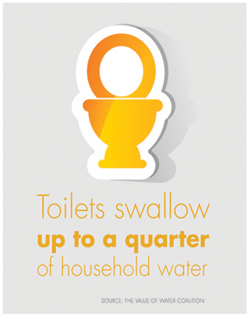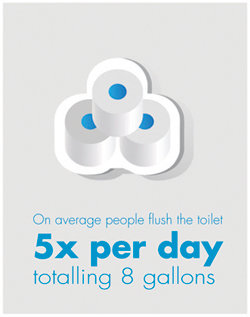Did you flush?
 How much water does one person flush down the toilet each year? If your toilet was installed in 2001 or later, it’s likely to be 1.6 gallons per flush.
How much water does one person flush down the toilet each year? If your toilet was installed in 2001 or later, it’s likely to be 1.6 gallons per flush.
That means (best case is 5 flushes per day) we use 8 gallons per day to cast off our waste. Annually, one person uses 2,920 gallons of water to flush the potty. Some (and I am not saying who) are still using 3.5 gallon-per-flush toilets throughout their communities. Those folks are using 10,220 gallons of water annually, per person, to flush the toilet.
Fun fact: In the U.S. multifamily industry there are 36,426,066 occupants living in 16,060,156 apartments (NMHC 2012 American Community Survey, 1-year estimates Sept. 2013). If we calculate this out, apartments are responsible for at least 106,372,872,720 gallons of water per year–water (and money) that goes down the toilet.
I know what you are thinking–how are these facts fun? How about ensuring that you have the resources needed to continue operating your business? (Fun!)
Consider that less than 1 percent of all the water in the world is drinkable. As our climate changes, so does our ability to tap into this resource.
For decades, water rates were low; we haven’t really had to think about what we were flushing away. However, in recent years, water is becoming a main player in the utilities section of our P&Ls. Drought, floods and the increase in fracking for natural gas production have impacted our supply of potable water. There are areas in the country where water is now restricted due to these changes. If drought becomes severe enough, theoretically we could lose the ability to operate our assets.
As Benjamin Franklin once wrote, “we all know the value of water when the well is dry.” Eventually, we could be looking at a Mars-like dust bowl landscape where our once lovely apartment community stood. Water supply is becoming a factor and its scarcity has led to rate increases. There are parts of the U.S. where rates are rising by 20 percent annually or more.
I know what you are thinking–you have submetering or a RUBS program. You can pass these increases onto your residents so it doesn’t matter. Wrong.
Consider a family’s budget for housing–every dollar allocated for water reimbursement is a dollar less that you can potentially capture on rent or other amenities. If we are not careful with how we manage our water usage at our sites, we could have our costs increase to a point that our rents flatten or residents move out. At that point, we don’t increase revenue: we can only offset cost. The best we can do is break even. My preference is to conserve our resources, lower the residents’ utility expenses and improve NOI. Now that’s fun.
 Back to the toilet. How do we control the consumption of this magnificent device? How do we change the world with a toilet? Answer–be brave, and go low-flow. How dare I utter those words.
Back to the toilet. How do we control the consumption of this magnificent device? How do we change the world with a toilet? Answer–be brave, and go low-flow. How dare I utter those words.
I may have just suggested that we build outhouses around our communities and encourage our residents to be “old timey” to save water. In some circles, low-flow is synonyms with flush twice and it doesn’t really work. You’re hesitant–you’ve been burned by low-flow before. Consider the technological advances and rapid rate of engineering advancement in recent years. Compare the fabulous brick cell phones of the 80s to the smart phones of today. What was cutting edge in the 1990s is obsolete today. Reflect that green tech is advancing at super science speeds. Then install one low-flow toilet in a unit and see if it works.
Recently I installed low-flow toilets at one of my communities. It went extremely well. I don’t want to be braggy, but let’s just say that water consumption dropped by more than 15 percent year-over-year in the first month. Resident water charges at this RUBS community decreased. Residents are happily paying less for water. How much easier will it be for my on-site team to renew residents?
You and I are responsible for the consumption of utilities within the units because we install, maintain and eventually upgrade the fixtures. If your property has a big water bill compared to mine, that is not because my demographic is made up of unbathed citizens who practice “if it’s yellow, let it mellow.” That’s silly. My demographic is not that different from yours. I just change the fixtures.
The funnest, most coolest fact of all: if we, as an industry changed out our toilets to low-flow, we could save 15,955,930,908 gallons of water annually (994 gallons per unit). Think what that might mean to your P&L at 1 cent per gallon. That’s the current effective rate for water and waste-water averaged for the 50 largest cities in the U.S.
What could that mean to your communities? What could that mean to your world?
Water you waiting for?
 Author Mary Nitschke is passionate about utilities. She is the first president of the Utility Management Advisory Board, holds an Energy Resource Management Certificate from UC Davis, two BAs from UC Berkeley and is Director of Ancillary Services for Prometheus Real Estate Group, Inc.
Author Mary Nitschke is passionate about utilities. She is the first president of the Utility Management Advisory Board, holds an Energy Resource Management Certificate from UC Davis, two BAs from UC Berkeley and is Director of Ancillary Services for Prometheus Real Estate Group, Inc.
Historical perspective
- March 2024
- February 2023
- July 2022
- March 2022
- June 2021
- February 2021
- August 2020
- February 2020
- July 2019
- April 2019
- June 2018
- April 2018
- October 2017
- May 2017
- November 2016
- June 2016
- November 2015
- June 2015
- September 2014
- June 2014
- April 2014
- December 2013
- July 2013
- December 2012
- July 2012
- October 2011


